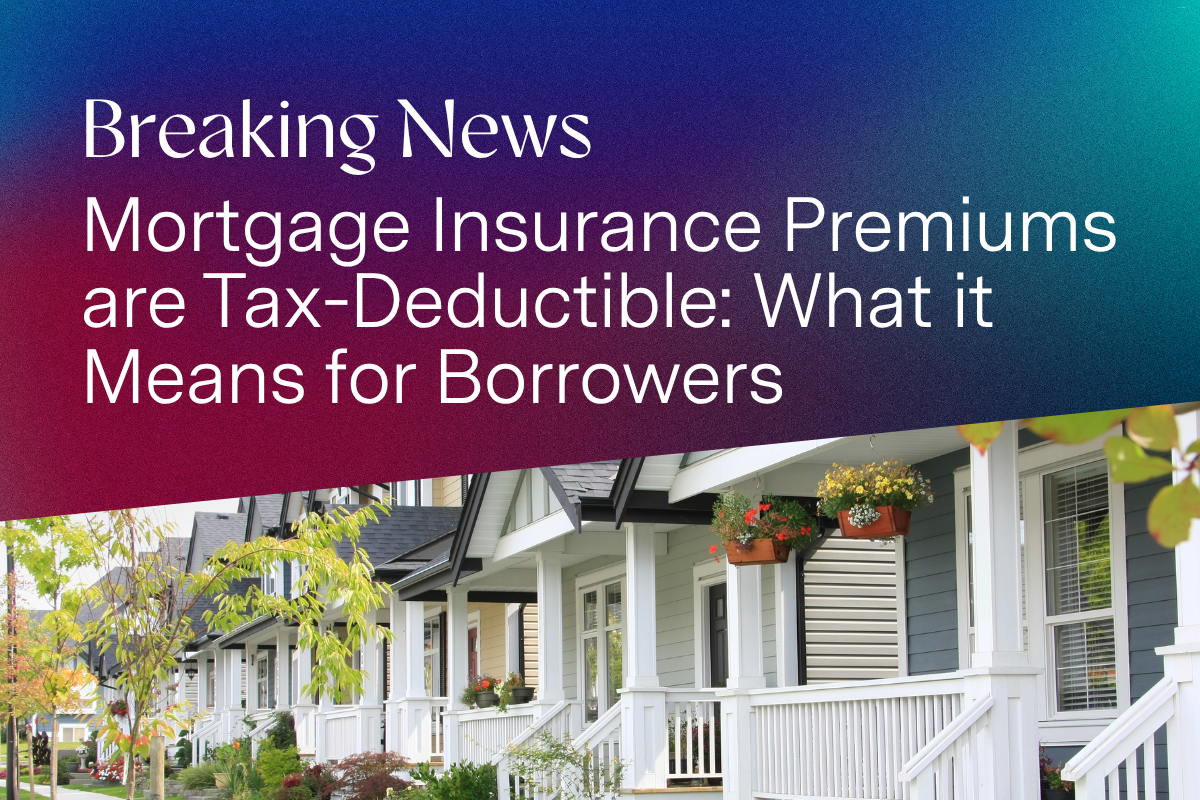July 24, 2024
Loan Officer, Mortgage Insurance, Servicing, Origination, Sales Tools, Homebuyer EducationDebunking 7 Common Mortgage Myths

Buying a home is an exciting event, but it can also be a little overwhelming, especially when it comes to mortgages. Accurate information can help prospective buyers make more informed decisions, but unfortunately, there’s also a lot of misinformation out there as well.
Let’s debunk some common mortgage myths that may arise when purchasing a home.
1. Renting Is Cheaper Than Owning
According to Bankrate’s Rent vs. Buy Affordability Study, renting a typical home is cheaper than buying in the country’s 50 biggest metro areas.[1] However, this only looks at the monthly cost right now and doesn’t take into account the equity buyers can build through homeownership.
When you purchase a home with a mortgage, your initial equity is the amount of your down payment. Home equity is the difference between the amount you owe on a mortgage and what the home is worth. As you make your monthly mortgage payments, your equity generally grows as you pay down the principal on the loan. Your equity also may increase further over time if the home’s value appreciates. It is important to note that property values can go up or down. However, Freddie Mac reports that the national average for home price appreciation is 3% per year.[2]
When you rent and make monthly payments, that money generally benefits the property owner through increased equity and potential appreciation, not the renter. Also, fixed-rate mortgages have more consistent and stable monthly principal and interest payments for the term of the mortgage, whereas rent may increase at the end of a lease term at the discretion of the landlord. Some borrowers may also be eligible to refinance their loan with a lower interest rate in the future, which may help lower their monthly payments.
Renting may help save on short-term costs, but obtaining a mortgage loan to purchase a home may also have advantages for some individuals, making more financial sense over time.
2. Low Credit Scores Can Prevent You From Being Approved for a Home Loan
A higher credit score can improve the odds of getting approved for a loan, but a lower credit score isn’t necessarily a deal breaker. Most conventional mortgages require a minimum credit score of at least 620, but this isn’t the same for every lender or every type of home loan. Some government-backed loans, such as some FHA loans, may have a lower minimum credit score requirement, and some lenders may have loan programs that permit borrowers to qualify with lower credit scores, subject to other restrictions and requirements.
3. You Need to Put 20% Down to Buy a Home
Up until 1956, banks wouldn’t lend to prospective buyers unless they made at least a 20% down payment. This deposit helps protect the lender in case the homeowner defaults on the loan. Now a 20% down payment may not always be needed to buy a home. If a borrower’s down payment is less than 20% on a conventional loan, lenders may require private mortgage insurance (PMI). PMI may result in a higher monthly mortgage payment, but it may not be a requirement for the entire life of the mortgage loan. This leads us into the next myth.
4. PMI Is on the Loan Forever and Should Be Avoided
Certain types of private mortgage insurance products won’t last forever. Depending on the product, borrowers may have options to request cancellation of PMI or to have their lender or servicer automatically terminate the PMI.
The Homeowner's Protection Act of 1998, commonly known as the HPA, establishes provisions for canceling and terminating PMI on certain types of loans and properties. Among other conditions, the HPA’s cancellation and termination provisions generally apply only to borrower-paid PMI on a first-lien mortgage secured by a single-family dwelling that is the principal residence of the borrower.
Please refer to the HPA for further details on its cancellation and termination provisions, as well as information on adjustable-rate mortgages, refinance transactions, and high-risk loans. Other options may be available to cancel or terminate PMI coverage, depending on the servicer or investor on the borrower’s loan.
5. PMI Only Benefits Lenders, Not Borrowers
It is true that PMI insures the mortgage lender against loss if the borrower defaults on the loan, but a PMI product may also benefit the borrower.
Since 1956, PMI has made homeownership more accessible. Instead of saving up enough to make a 20% down payment, borrowers can now purchase a home with a smaller down payment amount, allowing them to start building equity sooner. PMI can also be canceled in some circumstances as previously mentioned.
6. PMI Is Always Paid Monthly or as a Lump Sum at Closing
The most common ways to pay PMI is through monthly payments built into your mortgage payment or as a lump sum paid at closing on the loan. However, there are PMI options with different payment structures that might be available in some circumstances. There’s lender-paid PMI, where the lender pays on behalf of the borrower. In exchange, the borrower will often pay a higher interest rate on their mortgage. Another option is a split premium PMI, such as the CustoMIze SplitEdge option offered by Radian Guaranty. This is a hybrid option where the borrower pays part of the PMI premium upfront at closing, and the rest is paid monthly at an available rate that may better suit the borrower’s budget. Split premium PMI can help lower monthly mortgage payments without the borrower paying what would be a higher lump sum amount upfront.
7. FHA Financing Is Better Than Private Mortgage Insurance
FHA loans are backed by the Federal Housing Administration and may have more flexible standards than conventional home loans in some circumstances. This may make it easier for some borrowers, such as first-time buyers, to qualify for a mortgage.
Conventional mortgages may require borrowers to pay PMI if they make a down payment of less than 20% of the home's value. Borrowers aren’t required to have PMI on FHA loans, but they do have to pay a mortgage insurance premium to FHA, or MIP, at closing and an annual MIP, which is divided by 12 and charged in monthly installments that are added to the monthly mortgage payment.
The biggest difference between MIP and PMI is that MIP is required on all FHA loans, no matter how much the borrower puts down. For borrowers who put down less than 10% on an FHA loan, MIP is required for the life of the loan. Even with a down payment of 10% or more, MIP is required for 11 years.
Knowing the Truth and Making Informed Decisions
There are a lot of mortgage and PMI myths floating around today, which can lead to uninformed financial decisions. Mortgage insurance has helped expand access to homeownership, and upfront buydown options like CustoMIze SplitEdge can help better meet borrowers' needs. Plus, it may have the added benefit of a cancellation or termination option. Understanding how the mortgage process works, your rights and responsibilities as a borrower, and available options can help you achieve your goal of homeownership.
[1]Alex Gailey, Rent vs. Buy Affordability Study (Bankrate, April 2024)
[2]Understanding Your Home’s Equity (My Home by Freddie Mac)
© 2024 Radian Group Inc. All Rights Reserved. 550 East Swedesford Road, Suite 350, Wayne, PA 19087. “Radian” is a brand of Radian Group Inc., including its licensed insurance affiliates. Mortgage insurance is provided and underwritten by Radian Guaranty Inc., a wholly owned subsidiary of Radian Group Inc. with home offices at 550 East Swedesford Road, Suite 350, Wayne, PA 19087. Radian Guaranty Inc. is a monoline mortgage insurance company licensed to write business in all 50 states, the District of Columbia and Guam. This communication is provided for use by real estate or mortgage professionals only and is not intended for distribution to consumers or other third parties. This does not constitute an advertisement as defined by Section 1026.2(a)(2) of Regulation Z.

Mortgage Insurance Premiums are Tax-Deductible: What it Means for Borrowers
Mortgage insurance (MI) premiums are once again tax-deductible, and this time, the benefit is here indefinitely. Learn more about what that means for borrowers and loan officers.

Navigating the Spring Market: Tips for Buying or Selling Your Home
Spring is the busiest season in real estate, with warmer weather and blooming flowers highlighting a property's best features, and buyers prioritizing home tours before family obligations. Take a look at our checklists to help buyers and sellers prepare for the upcoming busy market.

Why Buying a Home Still Makes Sense in Today's Market: A 2025 Perspective
In today's real estate landscape, potential homebuyers might hesitate to enter the market. However, despite current challenges, several compelling reasons make homeownership an attractive option. With proper planning and understanding of available options, buying a home in 2025 can be a smart investment in your future.

Help Safeguard Property Transactions: A Deep Dive into Seller Impersonation Fraud
Understand the threat of seller impersonation fraud in real estate transactions. Help safeguard against these fraudulent activities by learning how scammers may use sophisticated methods to impersonate property owners and steal sale proceeds, warning signs to watch for, and potential protective measures including thorough identity verification, title insurance, and settlement services.

Beyond the Rate Drop: Helping to Future-Proof Your Lending Strategy
The recent drop in interest rates may lead to an influx of purchase and refi volume for lenders. With this shift on the horizon, learn more about positioning yourself to meet customer needs and help borrowers at scale through proper use of technology and innovative solutions.

Homebuying Trends in the United States
Discover the state of homeownership in the US, including the significant disparities across racial and ethnic lines and the challenges that homebuyers face. Learn about the importance of addressing these disparities and creating more equitable pathways to homeownership for building wealth and ensuring accessibility for all.

Explore the Evolving Traits of First-Time Homebuyers
Our infographic explores the characteristics and behaviors of today's first-time homebuyers, who prioritize homeownership as an important part of the American Dream despite economic and societal changes.

Loan Officers' Social Media Checklist: Best Practices to Help Build Your Brand
Loan officers can benefit from social media to connect with potential borrowers, build their brand, and establish themselves as a reliable authority in the mortgage industry. Optimizing social media profiles and posting strategies can attract new business and create lasting relationships with borrowers and business professionals. Check out our checklists to get started!

5 Tips for REO Disaster Planning
Read about preventative measures you can take to minimize damage and recover quickly when a natural disaster impacts your properties.

The American Dream of Homeownership Starts with Financial Literacy
As we celebrate National Financial Literacy month this April, it’s a reminder of the important role that financial literacy plays in preparing for the homebuying journey. Learn more about financial literacy for homebuyers.
